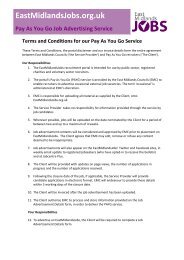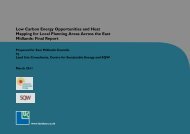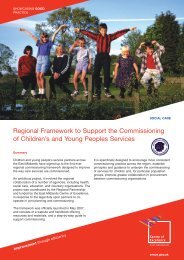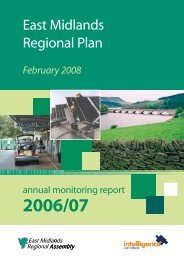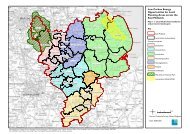East Midlands Regional Spatial Strategy 2005/06
East Midlands Regional Spatial Strategy 2005/06
East Midlands Regional Spatial Strategy 2005/06
Create successful ePaper yourself
Turn your PDF publications into a flip-book with our unique Google optimized e-Paper software.
<strong>East</strong> <strong>Midlands</strong> <strong>Regional</strong> <strong>Spatial</strong> <strong>Strategy</strong> Annual Monitoring Report <strong>2005</strong>/<strong>06</strong><br />
employment land. Current market demand shows<br />
that there may be a shortage of immediately<br />
available commercial space in the short term, with a<br />
longer term need to replace non-competitive sites<br />
with high quality fit for market locations.<br />
4.55 Derby’s employment land supply is currently<br />
healthy and is meeting its requirement to provide an<br />
adequate supply of different types to meet different<br />
market needs. The amount of land developed for<br />
employment uses in <strong>2005</strong>/<strong>06</strong> is around the average<br />
take-up rate exhibited in the City in recent years.The<br />
amount of land under construction points to a<br />
potential increase in the 20<strong>06</strong>/07 period, which is<br />
encouraging and demonstrates the success of the<br />
policy.<br />
4.56 In Nottinghamshire over the last 3 years, the<br />
proportion of PDL development has remained<br />
reasonably consistent after subtracting the Manton<br />
Colliery site take-up (2004/05) which heavily skews<br />
the figures, whereas the amount of greenfield<br />
development has steadily declined. Notable<br />
greenfield development is now complete on the<br />
Sherwood Business Park in Ashfield (close to the M1)<br />
and the Millennium Business Park north west of<br />
Mansfield.There are a number of significant<br />
outstanding PDL and greenfield sites available, most<br />
notably in Ashfield (where the majority of such sites<br />
are near to the M1), Mansfield, Newark & Sherwood<br />
and Rushcliffe.<br />
4.57 Significant Nottinghamshire sites include<br />
Nottingham Business Park currently being developed<br />
Policy 23: <strong>Regional</strong> Priorities for Town Centres and Retail Development<br />
as a sub regional business park and expansion land<br />
at the Boots site. Major redevelopment in the<br />
Regeneration Zone at the Waterside is also planned.<br />
4.58 The employment land area completed in<br />
Lincolnshire in <strong>2005</strong>/<strong>06</strong> was over twice that of the<br />
previous year.This is encouraging but should be<br />
treated with caution as these are the only two years<br />
for which complete data is available. Despite the<br />
range of data sources, it is not yet possible to say<br />
whether the target ‘to meet local needs’ is being met<br />
in Lincolnshire.<br />
4.59 In Leicestershire there have been slight<br />
floorspace decreases across all uses.This is similar to<br />
the result for England and the <strong>East</strong> <strong>Midlands</strong> as a<br />
whole, except for warehouse floorspace (which<br />
increased slightly in the <strong>East</strong> <strong>Midlands</strong>).Table 4.14<br />
shows a total of 15.8 ha of employment land lost,<br />
from just the 4 out of 7 districts in Leicestershire able<br />
to return data.This shows that allocations are being<br />
reviewed, and the recent sub regional employment<br />
land study will take this process further.There is less<br />
land committed in Leicestershire than elsewhere, but<br />
allocations are affected by the end date of 20<strong>06</strong> for<br />
local plans in the County, and the early stage in LDF<br />
preparation. Most development in Leicestershire is<br />
either in use class B8 or ‘mixed’ - i.e. not tied to any<br />
specific B use class at the time of monitoring.This<br />
also demonstrates a responsive position to market<br />
needs.<br />
Local authorities, emda and Sub-<strong>Regional</strong> Strategic Partnerships should work together on a sub-area<br />
basis to promote the vitality and viability of existing town centres, including those in Market Towns<br />
Target: To meet local needs<br />
Indicators:<br />
• Amount of completed retail, office and leisure development by local authority area<br />
• % of completed retail, office and leisure development in town centres<br />
• Outstanding planning permissions and allocations for retail, office and leisure development<br />
Results:<br />
4.60 See policies 2 and 22 for employment land and floorspace figures<br />
4.61 Data from www.iggi.gov.uk on Town Centres for 2002.<br />
58




